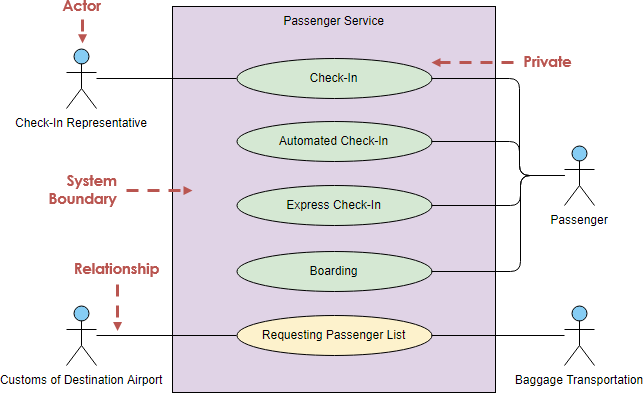Kasus penggunaan memodelkan pandangan pengguna terhadap fungsi sistem, yaitu,
- apa yang dilakukan sistem sejauh yang dipahami pengguna;
- Apa yang dilakukannya sangat berharga bagi pengguna.
- Model kasus penggunaan menyediakan cara untuk mengorganisir, menyusun, dan mendokumentasikan sejumlah besar informasi yang ditemukan selama akuisisi kebutuhan;
- Ini merupakan bagian integral dari fase deskripsi kebutuhan dalam proses pengembangan.
Kasus penggunaan sering kali bersifat grafis, dan diagram kasus penggunaan didukung oleh deskripsi teks, termasuk deskripsi kasus penggunaan dan peserta, serta skenario yang terkait dengan template kasus penggunaan yang membuat metode kasus penggunaan sederhana dan intuitif serta alat yang ideal untuk mendiskusikan dan memperjelas pemahaman pengembang tentang kebutuhan pengguna.
Setelah model kasus penggunaan selesai dan ditinjau bersama pengguna, itu membentuk kumpulan informasi terstruktur dasar yang akan digunakan untuk model lain dari sistem. Model kasus penggunaan juga berguna untuk menguji fungsionalitas sistem.
Model Kasus Penggunaan
Model kasus penggunaan terdiri dari:
- diagram kasus penggunaan,
- seperangkat deskripsi kasus penggunaan,
- seperangkat deskripsi aktor
- seperangkat skenario (dijelaskan oleh alur kejadian).
Diagram kasus penggunaan menggunakan empat konsep untuk memodelkan domain masalah secara grafis: kasus penggunaan, aktor, tautan hubungan, dan batas.
Kasus penggunaan: sebuah elips yang ditandai dengan nama kasus penggunaan. Berdasarkan konvensi, kita memulai setiap nama kasus penggunaan dengan kata kerja untuk menunjukkan bahwa kasus penggunaan mewakili suatu proses. Oleh karena itu, kita menggunakan “memelihara daftar pelanggan” alih-alih “daftar pelanggan”, dan “memproses kueri” alih-alih “kueri”.
Seorang aktor: sebuah gambar tongkat sederhana dengan nama aktor. Kita menuliskan nama aktor dengan huruf kapital untuk memudahkan identifikasi (misalnya, Pustakawan, Siswa).
Aktor dapat berupaorang, sistem lain, pemicu waktu, atau pemicu peristiwa. Seorang aktor menentukan peran yang dimainkan oleh pengguna atau sistem lain yang berinteraksi dengan subjek. Ini dapat mewakili peran yang dimainkan oleh pengguna manusia, perangkat keras eksternal, atau subjek lainnya.
Hubungan kasus penggunaan: sebuah garis yang menghubungkan aktor dengan kasus penggunaan. Garis ini menunjukkan kepada kita aktor mana yang terkait dengan kasus penggunaan mana. Hubungan ini juga disebut komunikasi.
Batas: Sebuah persegi panjang yang digambar di sekitar kasus penggunaan yang memisahkan mereka dari aktor untuk menggambarkan ruang lingkup sistem. Batas sistem bersifat opsional dan sering diabaikan.

Tujuan Diagram Kasus Penggunaan
Pemodelan kasus penggunaan dilakukan pada berbagai tahap proses pengembangan perangkat lunak berorientasi objek. Tingkat detail dan jenis informasi yang ditampilkan di setiap fase tergantung pada tujuan model. Informasi yang terkait dengan desain rinci atau implementasi sistem tidak termasuk dalam tahap awal, ketika tujuan utama adalah untuk berkomunikasi dengan pengguna. Kemudian, detail teknis, seperti desain antarmuka pengguna, akan ditambahkan untuk referensi programmer.
Kasus Penggunaan vs Diagram Kelas dalam Pengembangan Sistem
Penting untuk menyadari bahwa meskipun model kasus penggunaan membagi dan menyusun kebutuhan sistem, struktur ini tidak digunakan sebagai dasar untuk membangun sistem perangkat lunak baru yang, pada kenyataannya, disediakan oleh diagram kelas.
Model kasus penggunaan membangun sistem sebagai pandangan tugas utama pengguna.
Diagram kelas membangun sistem dengan menggunakan seperangkat komponen perangkat lunak logis (objek).
Diagram UML
- Apa itu UML?
- Mengapa Pemodelan UML?
- Ikhtisar 14 Jenis Diagram UML
- Apa itu Diagram Kelas?
- Apa itu Diagram Komponen?
- Apa itu Diagram Penempatan?
- Apa itu Diagram Objek?
- Apa itu Diagram Paket?
- Apa itu Diagram Struktur Komposit?
- Apa itu Diagram Profil?
- Apa itu Diagram Kasus Penggunaan?
- Apa itu Diagram Aktivitas?
- Apa itu Diagram Mesin Status?
- Apa itu Diagram Urutan?
- Apa itu Diagram Komunikasi?
- Apa itu Diagram Ikhtisar Interaksi?
- Apa itu Diagram Waktu
This post is also available in Deutsch, English, Español, فارسی, Français, 日本語, Polski, Portuguese, Ру́сский, Việt Nam, 简体中文 and 繁體中文.













